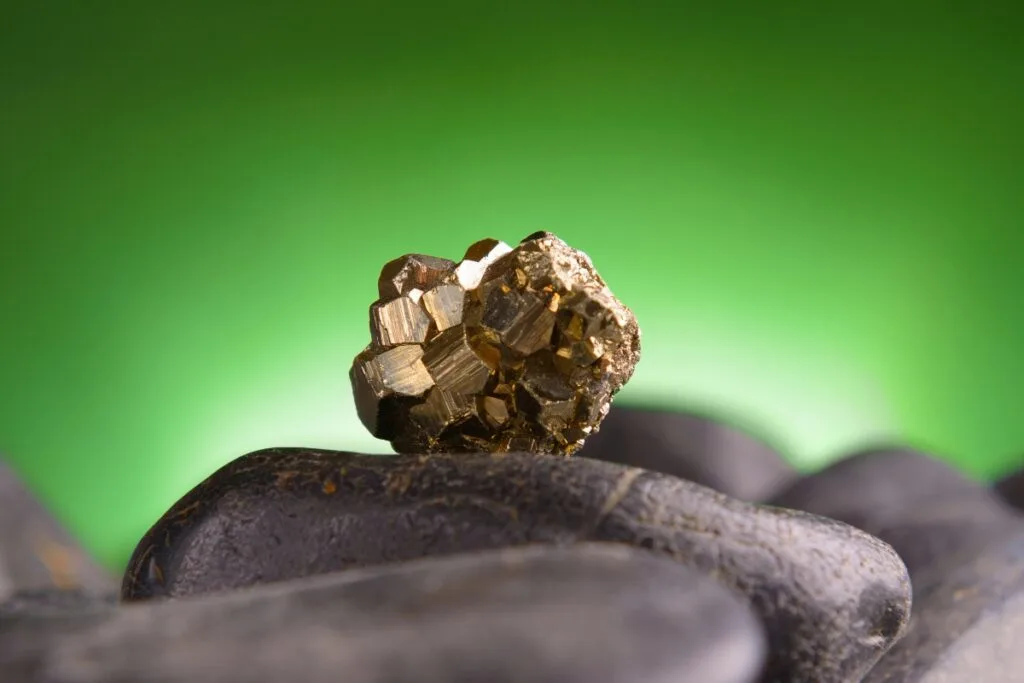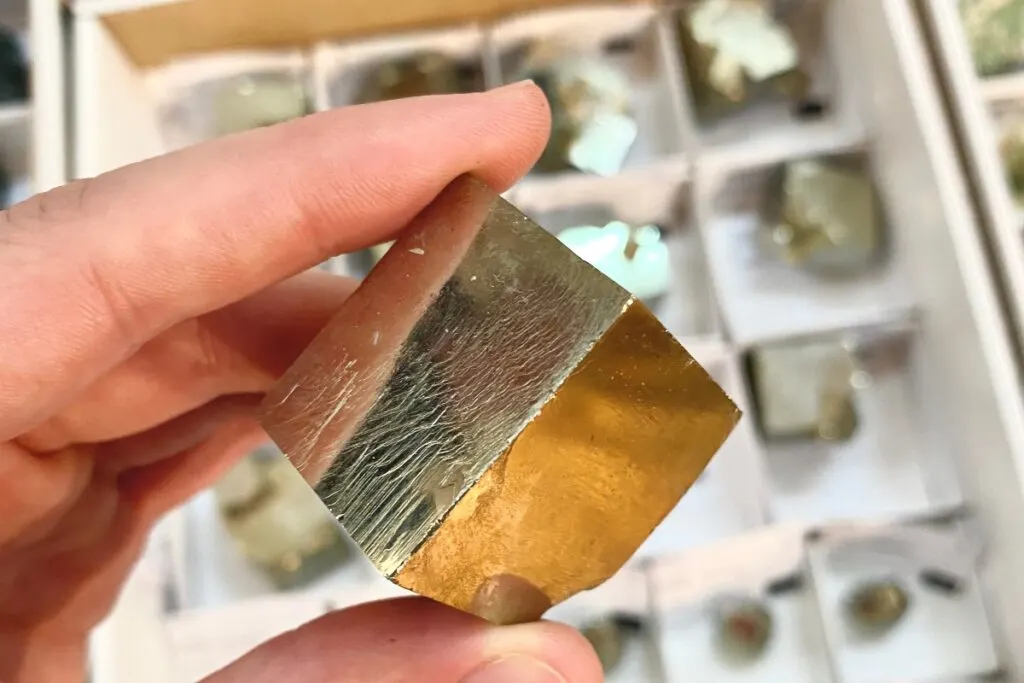As an Amazon Associate, I earn from qualifying purchases with no additional costs for you.
The mineral pyrite, also considered a gemstone, is famously known as the fool’s gold, due to its resemblance to the precious mineral. However, pyrite is not without its value or beauty. You can find this beautiful gemstone in various areas.
Pyrite is commonly found in most U.S. states. It is the most abundant sulfide mineral. States such as Utah, Missouri, and Tennessee are abundant in this gemstone. You can find pyrite specimens in many areas as it is mostly formed by common microbiological processes.
If you want to find pyrite near you in the U.S., the best thing to do is to know exactly how it forms, in which environments, and what are the best states to find it. Let’s explore these issues and find all the answers!

If you are interested in checking out the best books about rock and minerals identification you can find them by clicking here (Amazon link).
Where to Find Pyrite Near Me (Best Environments)
There are countless amounts of pyrite microscopic crystals throughout the earth, either in soils or sediments. This beautiful gemstone is mostly formed by bacteria that remove the oxygen from sulfate in water. The process results in the creation of sulfide that reacts with iron and forms pyrite.
Pyrite occurs in all types of rocks, sedimentary, igneous, metamorphic, or thermal veins. Some of the best environments to find pyrite are mines, hills, mountains, washes and draws, valleys, quarries, limestone deposits, road cuts, granite deposits, clay exposures, or creeks, among many other places.
Let’s explore some of these environments and see why pyrite forms in them.
Mines & Quarries
Since pyrite occurs in most types of rocks, mines, and quarries and some of the best places to find it. Pyrite forms at both low and high temperatures, so you can easily find it. Mine dumps are also excellent places to find pyrite. Mines situated near mountains are also prevalent in pyrite specimens.
Limestone & Granite Deposits, and Clay Exposures
Wherever you find limestone or granite deposits, chances are high you will also find pyrite. This is also true when it comes to clay exposures.
The bacteria are responsible for creating pyrite like to be both underground and near the surface. Road cuts and outcrops of rock are also excellent to explore to find pyrite, as you may also find more valuable specimens as well
If there are hills, mountains, valleys, washes, and draws near your location, you should search them for pyrite. Since pyrite is common, you may also find it near bodies of water, even near creeks.
TIP: Pyrite is believed to be quite a common mineral, however, pyrite fakes can be sometimes spotted. Check out the main differences between real and fake pyrite in the article below:
Real vs. Fake Pyrite: Focus on These 7 Differences
Where to Find Pyrite in the US? The Best Locations

You can find pyrite in more than half of all the U.S. states. It’s quite possible that it is present in all states, but what is certain is that there are certain locations more abundant than others in this gemstone and its variants.
| State | Locations |
|---|---|
| Utah | Pilot Range, Big & Little Cottonwood Mining District, Dugway Mining District |
| Indiana | Logansport, Bluffton, Parke County |
| Pennsylvania | Aughwick Creek, Monroe County, New Albany |
The best states in the U.S. where you can find pyrite include Utah, Missouri, Tennessee, Virginia, North Carolina, Connecticut, New Jersey, Pennsylvania, New York, Ohio, Indiana, Illinois, Wisconsin, New Mexico, Montana, Kansas, Idaho, and Washington. In some of these states, you can find even pyrite crystals, concretions, clusters, or geodes.
Let’s explore some of these states and see exactly where you can find pyrite and which types of pyrite!
BTW: Do you want to know more about rock and mineral identification? The books listed below are the best ones you can find on the internet (Amazon links):
- Smithsonian Handbooks: Rocks & Minerals
- Gemstone & Crystal Properties (Quick Study Home)
- Ultimate Explorer Field Guide: Rocks and Minerals (National Geographic Kids)
Best Utah Pyrite Locations
Utah is arguably the most abundant pyrite state in the United States. Most of the pyrite found here occurs in mines. In Box Elder County, there are several pyrite rockhounding locations. For example, Vipont Mine is a great area to explore.
At Pilot Range, you can find pyrite specimens in the mines in the Lucin mining district. The Raft River Mountains are also a beautiful area to visit and search for pyrite. You can find the gemstone in the area mines. The area mines near Promontory Mountains are also worth a shot!
Salt Lake County is another great location to begin your pyrite hunt in Utah! In Alta, many area mines are filled with pyrite specimens. You can also find it in the Big or Little Cottonwood mining districts.
Tooele County is even more abundant in pyrite than Salt Lake County. Here, you can find pyrite in the East Erickson mining district, in the area mines. The Clifton mining district and its area mines are also worth exploring.
The area mines in the Dugway mining district host, not just pyrite specimens, but also amethyst, or topaz gemstones. In the Stansbury Mountains, you can find pyrite alongside gold. The area mines near Gold Hill aren’t filled with gold, but rather the fool’s gold, pyrite. Topliff Hill is also worth exploring, as are the mines near Ophir, or the Silver Island Mountains.
Juab County is also abundant in pyrite specimens. The area mines around Desert Mountain, or Drum Mountains, are filled with pyrite. You can also explore the area mines around Fish Springs, or visit the Tintic Prince Mine, or Tintic Mountains to find pyrite specimens.
Beaver County is another exceptionally abundant region in pyrite. The area mines around Beaver Lake Mountains, Frisco, Lincoln Gulch, Wah Wah Mountains, Rocky Range, Star Range, or Bradshaw Mountains are fantastic places to explore for pyrite gemstones and other specimens. If you are near the San Francisco Mountains, the mines on the south side are filled with pyrite.
TIP: For a complete rockhounding guide in Utah, check out this article.
Missouri Pyrite Areas
Missouri is most likely the second-best U.S. state to find pyrite gemstones. In northwestern Missouri, you can visit Sugar Creek, and find pyrite specimens just southeast of Rushville. You should also give Sedalia a shot as well, especially the quarry west of town where large pyrite crystals were unearthed.
Northeastern Missouri is abundant in pyrite specimens. Here, you can find pyrite at the former strip mine at Finger Lakes State Park, or at Adrian’s Quarry off highway 63. In St. Francisville, on the banks of Weaver’s Branch, or the area quarries in Newark, pyrite is commonly present.
At the Fabius River, just east of Durham, you can find beautiful quartz and pyrite specimens. The area quarries around Troy are also worth searching. Danville Quarry or the quarry south of Hannibal town yields high-quality pyrite specimens.
Near Saverton, along highway 79, you can find pyrite specimens, or you can search for them in limestone at Defiance Quarry. In St. Louis, you can find pyrite in the road cuts between highways 141 and 30.
Southwestern Missouri also has its fair share of pyrite. You can find them in Liberal at the coal deposits, just 2.5 miles northeast, or at the granite pegmatite at Decaturville Crater. The many regional mines around Cole County are excellent places to search for pyrite as well.
Clusters of pyrite specimens can be found at the area coal mines near Tightwad. The mines and mine dumps around Eldon & Etterville, Wentworth, or the quarries near Joplin, are also fantastic places to explore.
Southeastern Missouri is also a “gold mine” when it comes to pyrite. You can find specimens at the area mines around Scotia, Steelville, Sullivan, Bixby, Cuthbertson Mountain, Palmer, Fredericktown, Eminence, or St. Francois County.
TIP: For a complete rockhounding guide in Missouri, check out this article.
Finding Pyrite in Tennessee
Central Tennessee has among the best pyrite areas one could hope for. For example, the regional gravels, streams, and fields around Cannon County are filled with pyrite specimens and other collectible goods.
The area creeks around Boatland have pyrite gemstones, and so do the area quarries around Carpenter Hollow and Buffalo Cove. The northwestern quarries near Livingston, or the area pits, quarries, and stream gravels near Marion County are also worth visiting.
In eastern Tennessee, you can find pyrite near Stony Creek, or in Greene, Hawkins, or Sullivan Counties, primarily in the regional quarries and mines. The area stream gravels around Copperhill or the area mines near Ducktown should also be explored. Another fantastic location is the western side of Ben Lomond Mountain.
TIP: For a complete rockhounding guide in Tennessee, check out this article.
FAQ About Finding Pyrite
Still did not find the answer to your questions about finding pyrite? Find frequently asked questions in the section below:
Where Does Pyrite Occur Naturally?
Oxygen-poor environments with sedimentary rocks and in the presence of iron and sulfur are excellent environments where pyrite occurs naturally.
Organic environments where decaying organic material consumes oxygen and gives way to sulfur, such as coal or black shale, are also areas where pyrite occurs naturally.
Where is the Best Place to Find Pyrite?
Pyrite is a fantastic mineral since it forms in so many mediums and at both high and low temperatures. The best places to find pyrite are either in mines or quarries. Mining dumps or road cuts are also great places to find pyrite specimens.
Is Pyrite Found Near Gold?
Pyrite is the most common sulfide mineral in the world, and due to this, it may occasionally be discovered near gold. The presence of pyrite doesn’t indicate the presence of gold. However, pyrite crystals might contain small amounts of gold.
Conclusion
Some may hate it due to its resemblance to gold, others might love it, especially in its cubic forms. No matter how you look at it, pyrite is among the most popular gemstones out there due to its intrinsic nature, looks, and commonality.
Certain types of pyrite specimens are more valuable than others, but whatever you intend to do with them, don’t forget the gemstone’s famous nickname.
TIP: Pyrite value can vary dramatically depending on the types of samples. Find out more about the pyrite’s value in the article below:
Pyrite Value: Main Factors & Prices for Different Units
